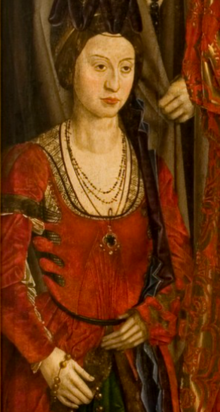Infanta Isabel of Coimbra (Isabella of Portugal) (1 March 1432 – 2 December 1455)[1] was a Portuguese infanta and Queen of Portugal as the first spouse of King Afonso V of Portugal.
| Isabel of Coimbra | |
|---|---|
 Detail of the Saint Vincent Panels masterpiece by Nuno Gonçalves | |
| Queen consort of Portugal | |
| Tenure | 6 May 1447 – 2 December 1455 |
| Born | 1 March 1432 Coimbra |
| Died | 2 December 1455 (aged 23) Évora |
| Burial | |
| Spouse | Afonso V of Portugal |
| Issue | |
| House | Aviz |
| Father | Peter, Duke of Coimbra |
| Mother | Isabella of Urgell |
Life
editBorn in Coimbra in 1432, Isabella was a daughter of the Infante Peter, Duke of Coimbra, and Isabella of Aragon, Countess of Urgel.[2][3] Her paternal grandfather was King John I of Portugal and her maternal grandfather was James II, Count of Urgel.
Isabella received a comprehensive Renaissance education influenced by the works of Christine de Pizan.[4]
Queen
editIsabella's father was the regent for her cousin Afonso V during his minority. In 1441, Pedro arranged the betrothal of Isabella and Afonso V.[3] Their engagement caused a conflict between Peter of Coimbra and Duke Afonso of Braganza, who had wished for the monarch to marry his granddaughter.[5]
Isabella and Afonso V were married on 6 May 1447.[3] Isabella was given the income of Santarém, Alvaiázere, Sintra and Torres Vedras at her wedding.[citation needed]
In 1448, the king took Afonso of Braganza as his advisor. Isabella's father rebelled and was killed in the Battle of Alfarrobeira in 1449,[6] and her brothers John and James were exiled. Isabella herself did not fall out of favour with the king, however, and she took control of the duchy of Coimbra until her brother John returned to Portugal in 1454.
In 1455, Isabella had her father honoured with a grand ceremony of exoneration at court and had him re-buried in a grand way.[7] Shortly after this, she died at age twenty-three, possibly from poisoning.[8][9] In her will, she left her inheritance to her sister, Philippa of Coimbra.[10]
Issue
editIsabella had three children:
- John, Prince of Portugal (29 January 1451)
- Joan, Princess of Portugal (6 February 1452 – 12 May 1490): Known as Saint Joan of Portugal or Saint Joan Princess. Beatified in 1693 by Pope Innocent XII.
- John II of Portugal (3 March 1455 – 25 October 1495): Succeeded his father as 13th King of Portugal.
Ancestry
edit| Ancestors of Isabel of Coimbra | |||||||||||||||||||||||||||||||||||||||||||||||||||||||||||||||||||||||||||||||||||||||||||||||||||||||||||||||||||||||||||||||||||||||||||||||||||||||||||||||||||||||||||||||||||||||||||||||||||||||||||||||||||||||||||||||||||||||||||||||||||||||||||||||||||||||||||||||||||||||||
|---|---|---|---|---|---|---|---|---|---|---|---|---|---|---|---|---|---|---|---|---|---|---|---|---|---|---|---|---|---|---|---|---|---|---|---|---|---|---|---|---|---|---|---|---|---|---|---|---|---|---|---|---|---|---|---|---|---|---|---|---|---|---|---|---|---|---|---|---|---|---|---|---|---|---|---|---|---|---|---|---|---|---|---|---|---|---|---|---|---|---|---|---|---|---|---|---|---|---|---|---|---|---|---|---|---|---|---|---|---|---|---|---|---|---|---|---|---|---|---|---|---|---|---|---|---|---|---|---|---|---|---|---|---|---|---|---|---|---|---|---|---|---|---|---|---|---|---|---|---|---|---|---|---|---|---|---|---|---|---|---|---|---|---|---|---|---|---|---|---|---|---|---|---|---|---|---|---|---|---|---|---|---|---|---|---|---|---|---|---|---|---|---|---|---|---|---|---|---|---|---|---|---|---|---|---|---|---|---|---|---|---|---|---|---|---|---|---|---|---|---|---|---|---|---|---|---|---|---|---|---|---|---|---|---|---|---|---|---|---|---|---|---|---|---|---|---|---|---|---|---|---|---|---|---|---|---|---|---|---|---|---|---|---|---|---|---|---|---|---|---|---|---|---|---|---|---|---|---|---|---|---|
| |||||||||||||||||||||||||||||||||||||||||||||||||||||||||||||||||||||||||||||||||||||||||||||||||||||||||||||||||||||||||||||||||||||||||||||||||||||||||||||||||||||||||||||||||||||||||||||||||||||||||||||||||||||||||||||||||||||||||||||||||||||||||||||||||||||||||||||||||||||||||
References
editCitations
edit- ^ Pereira & Rodrigues 1904, p. 1005.
- ^ Freitas 2011, p. 17.
- ^ a b c Rogers 1961, p. 59.
- ^ Freitas 2011, pp. 18–19.
- ^ Rogers 1961, pp. 60, 86.
- ^ Rogers 1961, p. 62.
- ^ Rogers 1961, pp. 68–69. "In 1455 Queen Isabela persuaded her husband, greatly pleased by the birth of his son João, to give her father the burial he merited. The King ignored the opposition from the Duke of Bragança and his son the Count of Ourém (now also Marquis of Valença), and brought the body to the Monastery of the Trinity in Lisbon. It was next moved to the Monastery of St. Eligius (Eloi) and finally transferred to Batalha, where it was interred with great pomp in the Chapel of the Founder."
- ^ Commire & Klezmer 2000, p. 792
- ^ Rogers 1961, p. 69. "Queen Isabel, twenty-three years old, soon joined her father in Batalha, for she died at the end of the same year. There were those who insinuated that she had been poisoned by her father's enemies."
- ^ Rogers 1961, p. 28.
Sources
edit- Commire, Anne; Klezmer, Deborah (2000). Women in World History: A Biographical Encyclopedia. Yorkin Publications. ISBN 978-0-7876-4066-8.
- Freitas, Isabel Vaz (2011). D. Isabel de Coimbra: Insigne Rainha (in Portguese). Quidnovi.
{{cite book}}: CS1 maint: unrecognized language (link) - Pereira, Esteves; Rodrigues, Guilherme (1904). Portugal: diccionario historico, chorographico, heraldico, biographico, bibliographico, numismatico e artistico (in Portuguese). Vol. III. Lisboa: J. Romano Torres.
- Rogers, Francis M. (1961). The Travels of the Infante Dom Pedro of Portugal. Harvard Studies in Romance Languages. Vol. XXVI. Cambridge: Harvard University Press.